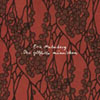Eric Malmberg, "Den g√•tfulla människan"
As much as I love the Hammond organ, there are few contexts in which Ican enjoy it. The instrument is so singular, its timbre so unique andpowerful, that I find it only works in positions of dominance, wherethe music's other parts are either entirely supplemental in nature orbarely there at all. Eric Malmberg's first group, the late Sagor &Swing, featured his Hammond as a foundation instrument in theirpop-length pastoral motifs, but I could never gain the access to theband's music that I wanted.
Häpna
 The condensed nature of their songs, andthe organ's drum-major role, always made Sagor, despite the music'saccessibility-especially for an instrumental act, seem too decorative,too thin for my tastes. Den gåtfulla människan,Malmerg's first solo release, is, in contrast, all I could have hopedfor: a wonderful organ-only record stretching Sagor's moody miniaturesinto spacey atmospheric tracks of retrograde sci-fi charm and confidentfilmic vision. The artist's organ settings look back to some of PopulVuh's more sedentary moments and capture the same dreamy nostalgia andprimordial quality through a similar mastery of subtle melody and moodsuggestion. According to Häpna, every sound here is organ-generated,which must somehow include the metronomic drum-machine that groundssome of the longer tracks. I am more impressed by the ambient orincidental harmonies that Malmberg manages through lateral pilings ofnon-distinct organ haze and swirling phase effects. I'm reminded ofBjörn Olsson's solo works which also function organ-centrically andaccomplish a similar retro aesthetic without granting it the full depthof the music. It's as if these musicians tap into universals ofstructure and mood existing as psychic constants, so as to always sounddated yet at the same time not. This music could as easily function asscore to a Disney film as to a Herzog; it is as direct and as opaquecompletely, special and not just for organ-lovers.
The condensed nature of their songs, andthe organ's drum-major role, always made Sagor, despite the music'saccessibility-especially for an instrumental act, seem too decorative,too thin for my tastes. Den gåtfulla människan,Malmerg's first solo release, is, in contrast, all I could have hopedfor: a wonderful organ-only record stretching Sagor's moody miniaturesinto spacey atmospheric tracks of retrograde sci-fi charm and confidentfilmic vision. The artist's organ settings look back to some of PopulVuh's more sedentary moments and capture the same dreamy nostalgia andprimordial quality through a similar mastery of subtle melody and moodsuggestion. According to Häpna, every sound here is organ-generated,which must somehow include the metronomic drum-machine that groundssome of the longer tracks. I am more impressed by the ambient orincidental harmonies that Malmberg manages through lateral pilings ofnon-distinct organ haze and swirling phase effects. I'm reminded ofBjörn Olsson's solo works which also function organ-centrically andaccomplish a similar retro aesthetic without granting it the full depthof the music. It's as if these musicians tap into universals ofstructure and mood existing as psychic constants, so as to always sounddated yet at the same time not. This music could as easily function asscore to a Disney film as to a Herzog; it is as direct and as opaquecompletely, special and not just for organ-lovers.
Häpna
 The condensed nature of their songs, andthe organ's drum-major role, always made Sagor, despite the music'saccessibility-especially for an instrumental act, seem too decorative,too thin for my tastes. Den gåtfulla människan,Malmerg's first solo release, is, in contrast, all I could have hopedfor: a wonderful organ-only record stretching Sagor's moody miniaturesinto spacey atmospheric tracks of retrograde sci-fi charm and confidentfilmic vision. The artist's organ settings look back to some of PopulVuh's more sedentary moments and capture the same dreamy nostalgia andprimordial quality through a similar mastery of subtle melody and moodsuggestion. According to Häpna, every sound here is organ-generated,which must somehow include the metronomic drum-machine that groundssome of the longer tracks. I am more impressed by the ambient orincidental harmonies that Malmberg manages through lateral pilings ofnon-distinct organ haze and swirling phase effects. I'm reminded ofBjörn Olsson's solo works which also function organ-centrically andaccomplish a similar retro aesthetic without granting it the full depthof the music. It's as if these musicians tap into universals ofstructure and mood existing as psychic constants, so as to always sounddated yet at the same time not. This music could as easily function asscore to a Disney film as to a Herzog; it is as direct and as opaquecompletely, special and not just for organ-lovers.
The condensed nature of their songs, andthe organ's drum-major role, always made Sagor, despite the music'saccessibility-especially for an instrumental act, seem too decorative,too thin for my tastes. Den gåtfulla människan,Malmerg's first solo release, is, in contrast, all I could have hopedfor: a wonderful organ-only record stretching Sagor's moody miniaturesinto spacey atmospheric tracks of retrograde sci-fi charm and confidentfilmic vision. The artist's organ settings look back to some of PopulVuh's more sedentary moments and capture the same dreamy nostalgia andprimordial quality through a similar mastery of subtle melody and moodsuggestion. According to Häpna, every sound here is organ-generated,which must somehow include the metronomic drum-machine that groundssome of the longer tracks. I am more impressed by the ambient orincidental harmonies that Malmberg manages through lateral pilings ofnon-distinct organ haze and swirling phase effects. I'm reminded ofBjörn Olsson's solo works which also function organ-centrically andaccomplish a similar retro aesthetic without granting it the full depthof the music. It's as if these musicians tap into universals ofstructure and mood existing as psychic constants, so as to always sounddated yet at the same time not. This music could as easily function asscore to a Disney film as to a Herzog; it is as direct and as opaquecompletely, special and not just for organ-lovers.samples:



